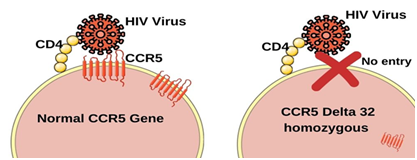

24th February 2023 (7 Topics)
Context
Recently a Dusseldorf patient has become have been “cured of HIV” achieved with a bone-marrow transplant from people carrying a specific HIV-resistant genetic mutation.
About
About HIV:
- HIV/AIDS is a spectrum of conditions caused by infection with the human immuno deficiency virus (HIV), a retrovirus.
- The human immunodeficiency virus (HIV) targets the immune system and weakens people's-defence against many infections and some types of cancer that people with healthy immune systems can fight off.
- The most advanced stage of HIV infection is acquired immunodeficiency syndrome(AIDS), which can take many years to develop if not treated, depending on the individual.
|
HIV (human immunodeficiency virus) is a virus that attacks cells that help the body fight infection, making a person more vulnerable to other infections and diseases. |
- Spread and causes: It is spread by contact with certain bodily fluids of a person with HIV, most commonly during unprotected sex (sex without a condom or HIV medicine to prevent or treat HIV), or through sharing injection drug equipment.
- If left untreated, HIV can lead to the disease AIDS (acquired immunodeficiency syndrome).
- Treatment: The human body can’t get rid of HIV and no effective HIV cure exists.
- AIDS is the late stage of HIV infection that occurs when the body’s immune system is badly damaged because of the virus.

What is CCR5 mutation and how does it fight off HIV?
- HIV (Human Immunodeficiency Virus) mainly attacks the CD4 immune cells in the human body, thereby reducing a person’s ability to fight off secondary infections.
- The CCR5 receptors on the surface of the CD4 immune cells act as a doorway for the HIV virus.
- However, the CCR5-delta 32 mutation prevents these receptors used by the HIV virus from forming on the surface, effectively removing the doorway.
- Only 1 per cent of the people in the world carry two copies of the CCR5-delta 32 mutation – meaning they got it from both their parents – and another 20 per cent carry one copy of the mutation, mainly those of European descent.
Effectiveness of CCR5 mutation against HIV:
- With the mutation existing in very few people and nearly 38.4 million people living with HIV across the world, it would be very difficult to find a matching donor in the first place.
- The mutation occurs mainly among Caucasians, and the donor pool shrinks further for many, especially those from countries with high HIV burdens.
- However, even if donors were to become available, experts believe it is highly unlikely that bone marrow transplants can be rolled out for all those with HIV.
- This is because it is a major procedure with high risks associated, especially that of the person rejecting the donated marrow.
- There is also the likelihood of the virus mutating to enter the cells through other mechanisms in such persons.
More Articles


